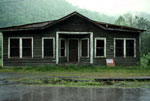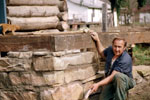"Holding up the Mountains": Forest Talk as Historical Discourse
As talk about change, forest talk is part of a larger effort to construct local history through historical discourse.11 Constructing history, people relate themselves to their surroundings and position that relationship in time. History is, as Henry Glassie writes, "a prime mode of cultural construction…a way people organize reality to investigate truth to survive in their own terms."12 On Coal River, historical discourse renders coherent a struggle to maintain "place" on land that has shifted over that past century into the control of absentee owners. Through sayings, place name etymologies, genealogical digressions, local anecdotes, and historical recollections, speakers challenge a historical process that separates people from their land and resources. Authenticating their relationship to the land, such talk defends against the cultural disappearance (via stereotyping) that operates in tandem with literal removal.
Local historical discourse does not separate the woods from the mountains, for to do so literally would be disastrous: "What's holding up the mountains? Trees!" as Jerry Bone, thirty-eight, of Dry Creek put it. Nor does it separate woods from people: "They're taking away our dignity by destroying our forest," wrote Vernon Williams on a recently circulated petition to study and protect the forest. Viewed historically, knowledge of the mixed mesophytic has aided physical and cultural survival over the past century. During what Mae Bongalis called "the Hoover times," reliance on wild foods minimized dependency on the company store. "Back in the bad times," said Bongalis, "I seen people go out, be snow on the ground. Rake that snow and leaves off, you find little sprouts like that and pick it to eat. People didn't even have grease to go on the stuff after they cooked it. They just boiled it and ate it. And we had plenty."
Recalling when, in a later era, the mines were idled during "slack run," Dave Bailey cited the incorporation of "commodities"--food from the government--into family menus that included "blackberry flitters" from canned wild blackberries, "shoestring beans" dried and reconstituted from the garden, and memorable casseroles built around "Spam" (canned meat) from the government. For some currently "cut off from work" the woods continue to be culturally as well as economically sustaining. "I make my living in construction," wrote Dennis Price, forty, on the above-mentioned petition. "But really, I consider myself a ginsenger." His advice: "Don't lay around on your deadbeat ass and get a check from the government. There's ginseng, there's bloodroot, there's yellow root."
Place names and related narratives attach family and community history to the surrounding terrain. Taken as a whole, the names conferred on nearly every wrinkle seen from the air index forest history: Ground Squirrel Hollow, Honey Camp Hollow, Redbud Hollow, Sugar Camp Hollow, Seng Creek, Isaac's Fork, Spring Hollow, Dogfight, Ma Kelly Branch. "Each hollow has a name," emphasized Dennis Dickens, referring to the coves (also called "swags" or "drains") flanking the slopes rising away from Peachtree Creek:
Now Bear Branch, what gave it its name, a man cut a bee tree, and had more honey than he could carry and he left a bucket a-sitting there. And when he went back to get it, a bear had picked the bucket up and carried it out the mouth of the hollow and down the creek below there, past old Mose's house, and there set his bucket on the walk where the bear'd eat the honey out of it.
Other thresholds to local history in the forest include the "Marrying Rock," on Bolt Mountain where couples awaited the blessing of the circuit rider; family cemeteries, old homeplaces, wagon roads that connected families scattered on both sides of a ridge, and sites associated with Indian ancestors, like the rock mortars Mae Bongalis's grandmother showed her as they searched for red pucoon and slippery elm. "My great grandfather was an Indian witch doctor," said Bongalis.
My grandmother and all her brothers, they lived in Indian Creek. She'd take us up in them woods and she'd take an old stick and go to raking leaves and dirt, and show us in the cliffs where there was a hole--be about this big, then go down til it was little. They'd take what they call a hickory maul, and they'd put their corn down in that hollow, and then beat it with that maul til they had meal to bake bread, and she said, they built a fire on these big rocks and get them real hot and then they wiped them off and put their corn meal on and stir it up on that and bake it.
The rocks were charred when Bongalis was a girl, and the mature trees her grandmother pointed out were saplings when their ancestors hung meat on them to cure.
Such accounts, which bolster a sense of belonging on the land, also help to maintain a critical perspective on the historical process that has shaped the region's destiny. Recurrent in oral tradition are vignettes that dramatically pit the knowledge of corporate agents against the intimate knowledge of area residents. "Now what did you say to the guy when he told you you could get three hundred dollars for your walnut if it was one inch larger?" John Flynn asked Dennis Dickens. "I told him I'd just wait for it to grow," Dennis Dickens responded, to appreciative guffaws. "You know, that walnut tree is just about the same age I am."13
In national news coverage of environmental crises, one often hears the argument that environmental regulation costs jobs. Indeed, high rates of unemployment in places like Coal River are usually cited to rationalize controversial forms of resource extraction and use. In Stickney, Gary Bone, an unemployed coal miner, challenges the pitting of economic growth against environmental health: "You can't destroy our environment just because we have a depressed economy."
The talk on Coal River constitutes a missing perspective in the national environmental debate. Shifting toward "ecosystem management," the U.S. Forest Service grapples with the question of where human beings fit into ecosystems." The task is to create environmental policy that registers local as well as national and global concerns. Sifting through the rubble of progress, tallying the cost, voices beneath the canopy compel a hearing.
—by Mary Hufford
From Folklife Center News 17, No. 3 (Summer 1995)

![]()
![]() The Coffee Pot, once a favorite gathering place in Edwight, on the eve of its demolition. Lyntha Scott Eiler. 1996/05/25. Library of Congress American Folklife Center.
The Coffee Pot, once a favorite gathering place in Edwight, on the eve of its demolition. Lyntha Scott Eiler. 1996/05/25. Library of Congress American Folklife Center.

![]()
![]() Woody Boggs recycling the wormy chestnut timbers from the dismantled Coffee Pot into a kitchen for a new log cabin in Pettry Bottom. Woody Boggs. 1999. Library of Congress American Folklife Center.
Woody Boggs recycling the wormy chestnut timbers from the dismantled Coffee Pot into a kitchen for a new log cabin in Pettry Bottom. Woody Boggs. 1999. Library of Congress American Folklife Center.

![]()
![]() Woody Boggs, laying a foundation of cut sandstone from the chimney and foundation of a dismantled house on Rock Creek. Woody Boggs. 1999. Library of Congress American Folklife Center.
Woody Boggs, laying a foundation of cut sandstone from the chimney and foundation of a dismantled house on Rock Creek. Woody Boggs. 1999. Library of Congress American Folklife Center.

![]()
![]() A wheelbarrow made by Joe Pettry, Woody Boggs' maternal grandfather, parked beside the finished log cabin where neighbors gather each Friday evening to make music. Mary Hufford. 2000/04/15. Library of Congress American Folklife Center.
A wheelbarrow made by Joe Pettry, Woody Boggs' maternal grandfather, parked beside the finished log cabin where neighbors gather each Friday evening to make music. Mary Hufford. 2000/04/15. Library of Congress American Folklife Center.

![]()
![]() Mae Bongalis and John Flynn, at the 1995 Ramp Supper. Terry Eiler. 1995/04/22. Library of Congress American Folklife Center.
Mae Bongalis and John Flynn, at the 1995 Ramp Supper. Terry Eiler. 1995/04/22. Library of Congress American Folklife Center.